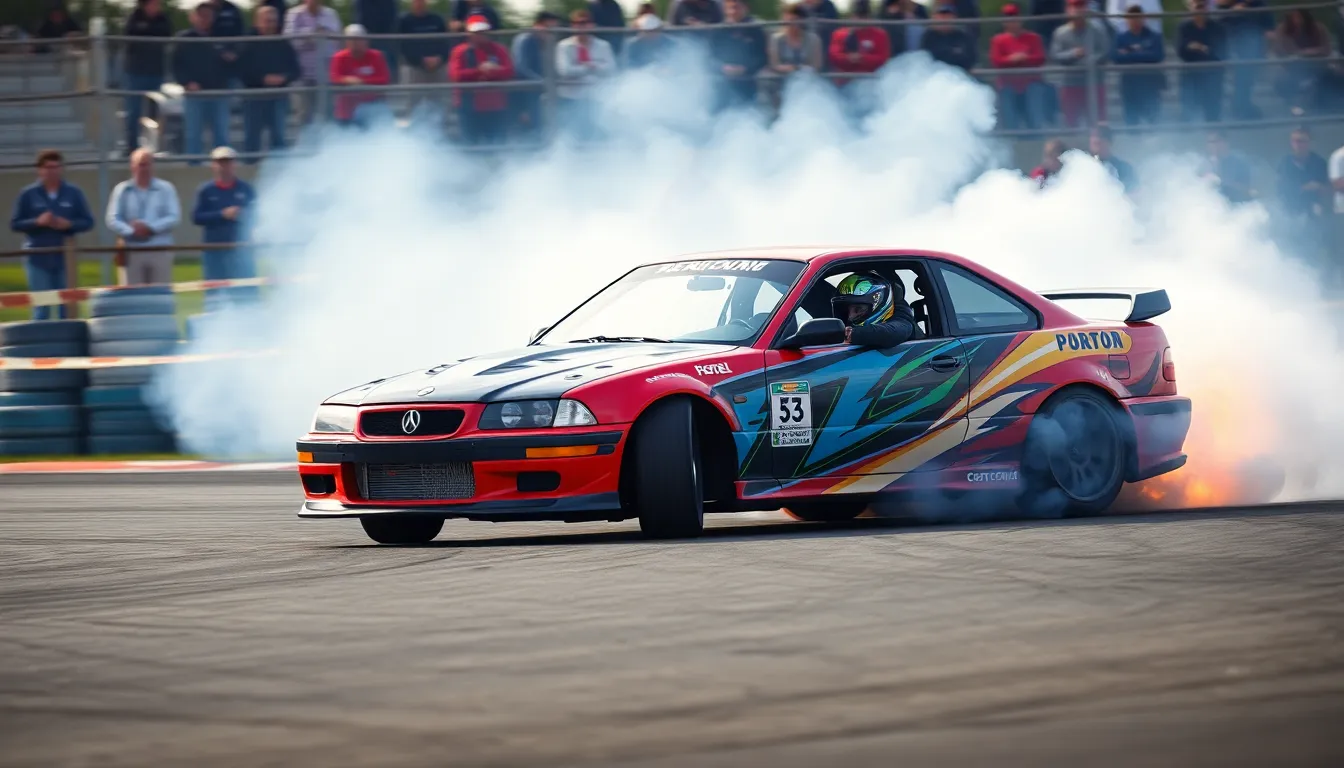Drifting transforms ordinary driving into pure automotive artistry. We’ve all watched in awe as skilled drivers slide their cars sideways through corners with perfect control while smoke billows from spinning tires. What started as a driving technique on Japan’s mountain roads has evolved into one of motorsport’s most thrilling spectacles.
Today’s drifting scene captivates millions of enthusiasts worldwide. We see everything from grassroots weekend warriors practicing in empty parking lots to professional competitions featuring purpose-built machines worth hundreds of thousands of dollars. The sport demands incredible skill precision and a deep understanding of vehicle dynamics.
Whether you’re curious about getting started or want to understand what makes drifting so addictive we’ll break down everything you need to know. From the essential techniques and car modifications to the culture that surrounds this sideways industry of motorsport.
Understanding the Fundamentals of Drifting Cars
Building on drifting’s rich heritage from Japan’s mountain roads, we need to explore what transforms an ordinary vehicle into a sideways-sliding machine. The foundation of successful drifting lies in understanding both mechanical requirements and physical principles.
What Makes a Car Suitable for Drifting
Rear-wheel drive systems form the backbone of every capable drift car because they allow drivers to break traction at the rear wheels while maintaining steering control. We find that cars like the Nissan 240SX, BMW E36, and Mazda RX-7 dominate drift scenes worldwide due to their optimal weight distribution and mechanical layout.
Weight distribution plays a crucial role in drift car selection, with the ideal setup featuring a 50/50 or slightly rear-biased balance. Cars with heavy front ends like most front-wheel drive vehicles resist the sideways motion essential for sustained drifting.
Power delivery characteristics determine how easily a car initiates and maintains drifts, with naturally aspirated engines often providing more predictable throttle response than turbocharged alternatives. We recommend engines producing between 200-400 horsepower for beginners, as this range offers enough power to break traction without becoming unmanageable.
Suspension geometry must accommodate the extreme angles and forces generated during drifting, requiring modifications like adjustable coilovers, reinforced mounting points, and increased steering angle. Stock suspension systems rarely provide the adjustment range needed for competitive drifting performance.
Manual transmissions remain the preferred choice among drift enthusiasts because they offer precise control over power delivery and engine braking during transitions. Automatic transmissions can work but typically require important modifications to handle the demands of sustained high-RPM operation.
The Physics Behind Controlled Oversteer
Traction circles explain how tires can only provide a finite amount of grip that must be shared between acceleration, braking, and cornering forces. We manipulate these forces to intentionally exceed the rear tires’ grip threshold while keeping the front tires within their traction limits.
Weight transfer dynamics occur when we apply throttle, brake, or steering inputs, shifting the car’s mass and changing tire loading. Drifting exploits these weight transfers to reduce rear tire grip while maintaining front-end control through proper steering and throttle modulation.
Slip angles represent the difference between where a tire points and where it actually travels, with controlled slip angles creating the signature sideways motion of drifting. We maintain optimal slip angles through constant adjustments to steering input, throttle position, and vehicle speed.
Counter-steering techniques involve turning the steering wheel opposite to the direction of the turn to maintain control during oversteer conditions. This seemingly counterintuitive action keeps the car balanced and prevents it from spinning completely around.
Throttle modulation serves as the primary tool for controlling drift angle and maintaining vehicle balance throughout a corner. We use precise throttle inputs to increase or decrease rear wheel spin, directly affecting the car’s drift angle and speed.
Essential Modifications for Building Drifting Cars
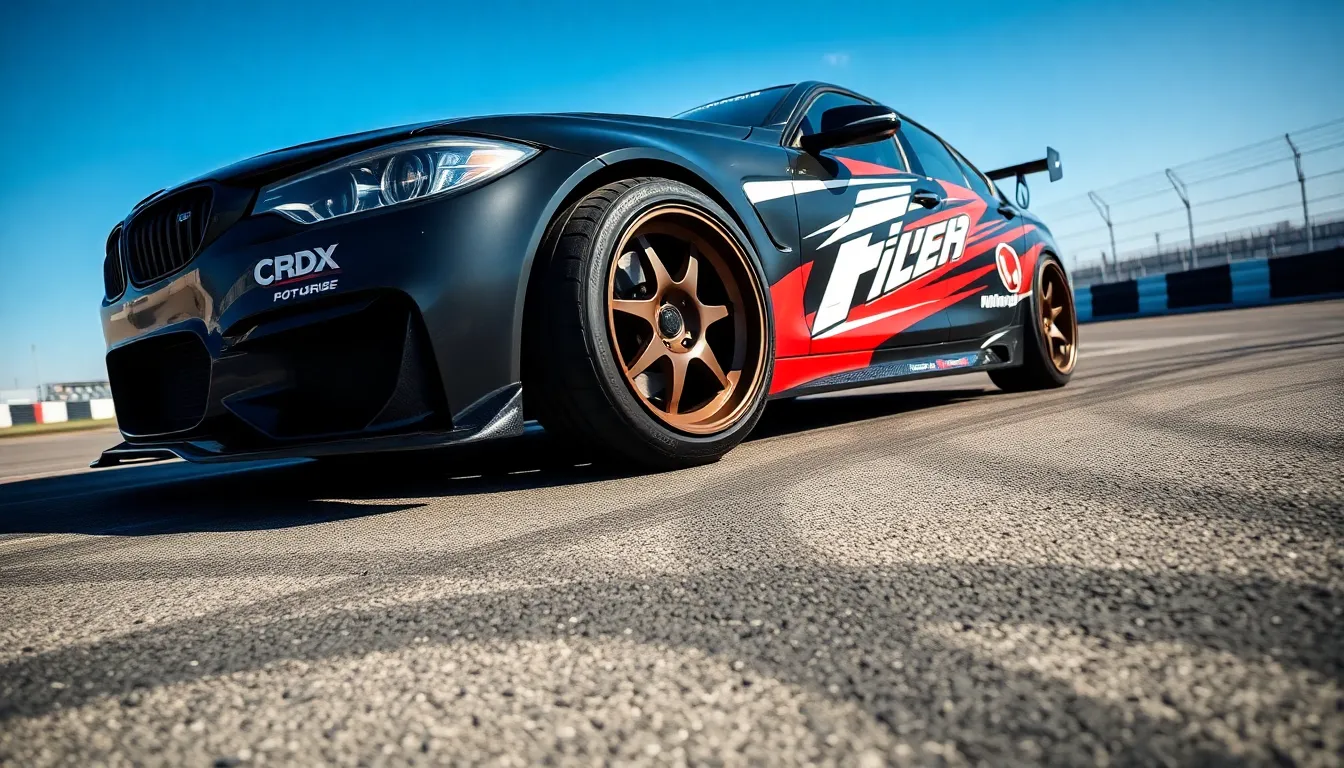
Transforming a stock vehicle into a capable drift machine requires exact modifications that work together to achieve controlled sideways motion. We’ll explore the three fundamental upgrade categories that form the backbone of any serious drift build.
Suspension Upgrades and Setup
Coilover systems provide the foundation for drift car suspension setups, offering independent adjustment of ride height, compression, and rebound damping. We typically install coilovers with spring rates between 8-12 kg/mm in the front and 6-10 kg/mm in the rear to maintain proper weight transfer characteristics.
Adjustable suspension arms replace factory components to achieve aggressive alignment settings that stock parts can’t accommodate. Control arms, toe arms, and tension rods allow us to dial in exact camber angles (typically -2° to -4° front, -1° to -2° rear) and toe settings that enhance tire contact patches during drift transitions.
Anti-roll bar modifications help fine-tune handling balance by controlling body roll during weight transfer. We often install stiffer front sway bars and softer or disconnected rear bars to promote rear end rotation while maintaining front grip for steering control.
Lowered ride height improves the car’s center of gravity and reduces suspension geometry changes during cornering. Most drift cars sit 1-3 inches lower than stock height, striking a balance between improved handling and adequate clearance for track conditions.
Limited Slip Differentials and Their Importance
Welded differentials represent the most budget-friendly option for amateur drifters, permanently locking both rear wheels together for consistent power delivery. We see welded diffs primarily in entry-level builds where cost takes priority over street drivability and tire wear concerns.
Mechanical limited slip differentials offer the perfect compromise between performance and practicality, using clutch packs or gear mechanisms to transfer torque between wheels. Popular options include OS Giken, Cusco, and Kaaz units with lock rates ranging from 1-way (on acceleration only) to 2-way (acceleration and deceleration).
Electronic limited slip systems provide variable locking characteristics through computer-controlled clutch engagement. We find these systems particularly effective in modern drift cars where precise torque management enhances both performance and consistency.
Differential maintenance becomes crucial for drift cars due to increased stress from constant sideways motion and aggressive driving. Regular fluid changes every 5-10 events and periodic clutch pack inspections ensure reliable operation throughout the season.
Engine Modifications for Power Delivery
Turbocharger upgrades transform naturally aspirated engines into torque-rich powerplants ideal for initiating and maintaining drifts. We typically see builds ranging from 300-600 horsepower, with larger turbochargers providing the broad torque curves that make drift initiation effortless across various speeds.
Engine management systems replace factory ECUs to optimize fuel delivery and ignition timing for modified engines. Standalone units like Haltech, AEM, and Link allow us to create custom maps that prioritize smooth power delivery over peak horsepower numbers.
Cooling system enhancements prevent overheating during extended drift sessions where engines operate under sustained high load conditions. Upgraded radiators, oil coolers, and intercoolers maintain consistent temperatures even during hot weather events.
Transmission modifications support increased power levels while providing the gear ratios needed for different track layouts. Close-ratio gearsets and upgraded clutches handle the additional torque while shorter final drive ratios keep engines in their optimal power bands.
Top Drift Car Models Every Enthusiast Should Know
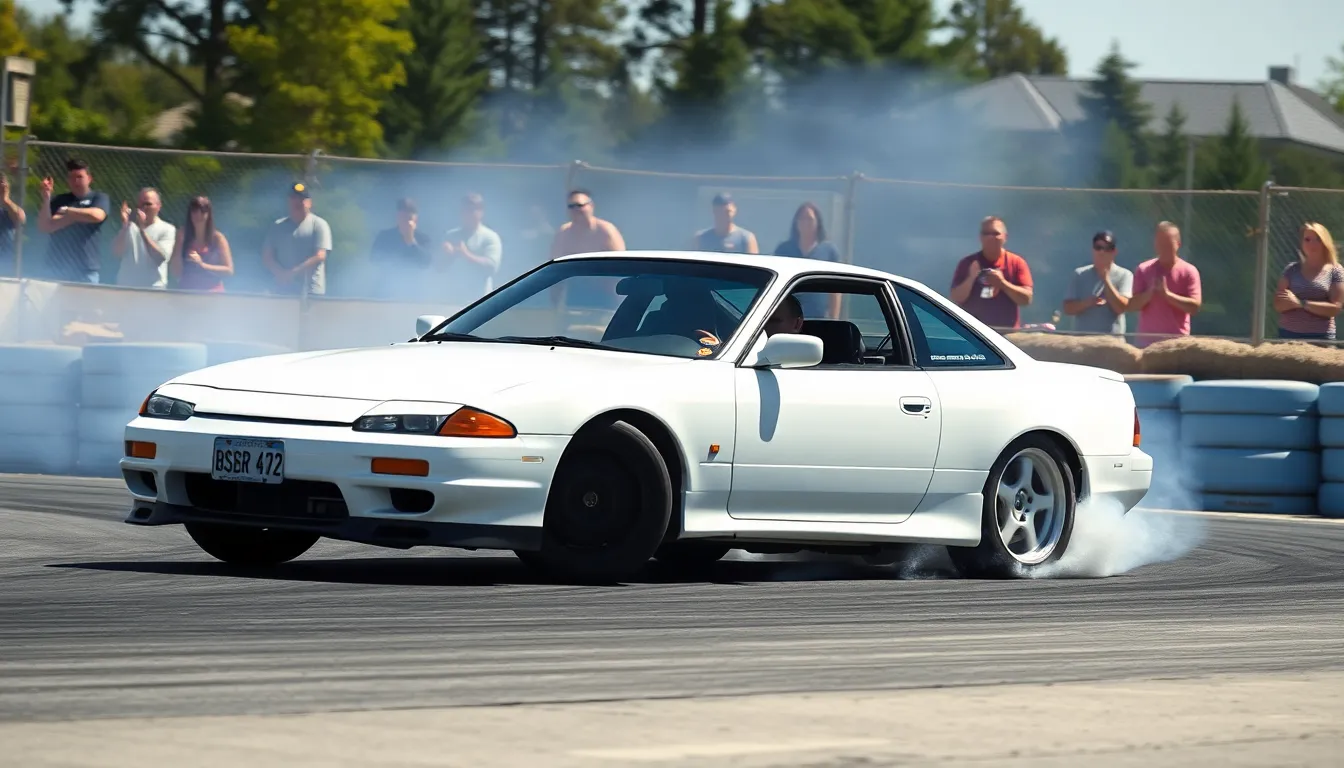
We’ve covered the essential modifications and techniques, but choosing the right platform matters just as much for successful drifting. These legendary models have earned their reputation through decades of proven performance on drift circuits worldwide.
Nissan 240SX and S-Chassis Variants
240SX models represent the gold standard for drift enthusiasts across America and beyond. We consistently see these vehicles dominating grassroots events because of their perfect weight distribution and naturally balanced chassis dynamics.
S13 models (1989-1994) offer lightweight construction at approximately 2,700 pounds with excellent steering feedback for precise control. S14 variants (1995-1998) provide slightly more power from their SR20DE engines while maintaining the same rear wheel drive architecture that makes these cars so predictable.
Engine swap potential makes S-chassis vehicles incredibly versatile for different power levels and budgets. Popular conversions include the SR20DET turbo four cylinder for 250+ horsepower or LS V8 swaps for those seeking 400+ horsepower builds.
Parts availability remains exceptional even decades after production ended, with both OEM components and aftermarket support readily accessible. We find replacement body panels, suspension components, and performance upgrades easily sourced from multiple manufacturers.
BMW E30 and E36 Series
E30 models (1982-1994) deliver exceptional build quality and engineering precision that German manufacturers are known for. We appreciate their robust construction and perfectly balanced 50/50 weight distribution that creates predictable handling characteristics.
M50 and M52 inline six engines in E36 models (1990-2000) produce smooth power delivery with natural torque curves ideal for maintaining controlled slides. These motors respond well to basic modifications like intake and exhaust upgrades while maintaining excellent reliability.
Differential options include factory limited slip units that provide consistent traction without the harshness of welded differentials. We often recommend E30s for beginners because their forgiving nature helps drivers learn proper technique without aggressive snap oversteer tendencies.
Suspension geometry was engineered for performance driving from the factory, requiring minimal modifications to achieve competitive drift setups. Coilover installations typically transform these vehicles into capable track weapons with proper alignment specifications.
Mazda RX-7 and Rotary Engine Benefits
RX-7 models showcase rotary engine technology that creates unique advantages for drifting applications. We value their incredibly low center of gravity and compact engine placement that enhances overall vehicle balance.
FC generation (1986-1991) and FD models (1993-1995) both feature naturally aspirated and turbocharged rotary options producing smooth power bands perfect for throttle modulation during slides. Turbo variants deliver impressive power to weight ratios exceeding most conventional piston engines.
Weight distribution favors the rear axle slightly, creating natural oversteer tendencies that experienced drivers can exploit for easier drift initiation. We find this characteristic particularly beneficial for maintaining long angle entries into corners.
Rotary engine characteristics include high RPM capability exceeding 9,000 RPM redlines and instantaneous throttle response due to minimal rotating mass. But, these engines require specialized knowledge for maintenance and rebuilds compared to conventional powerplants.
Toyota AE86 and Its Legendary Status
AE86 models (1983-1987) earned legendary status through Initial D anime popularity and grassroots drifting success worldwide. We recognize these vehicles as the foundation that launched drifting culture beyond Japan’s mountain passes.
Rear wheel drive configuration paired with lightweight construction around 2,300 pounds creates an ideal platform for learning drift fundamentals. The 4A-GE twin cam four cylinder produces modest power that prevents overwhelming novice drivers while teaching proper technique.
Suspension design utilizes MacPherson struts up front and a four link rear setup that responds predictably to driver inputs. We often recommend AE86s for first time drifters because their gentle nature forgives mistakes while building confidence.
Cultural significance extends beyond performance capabilities, as these cars represent the authentic spirit of drifting’s origins. Market values have increased dramatically due to their iconic status, with clean examples commanding premium prices that reflect their historical importance in motorsports culture.
Learning the Core Drifting Techniques
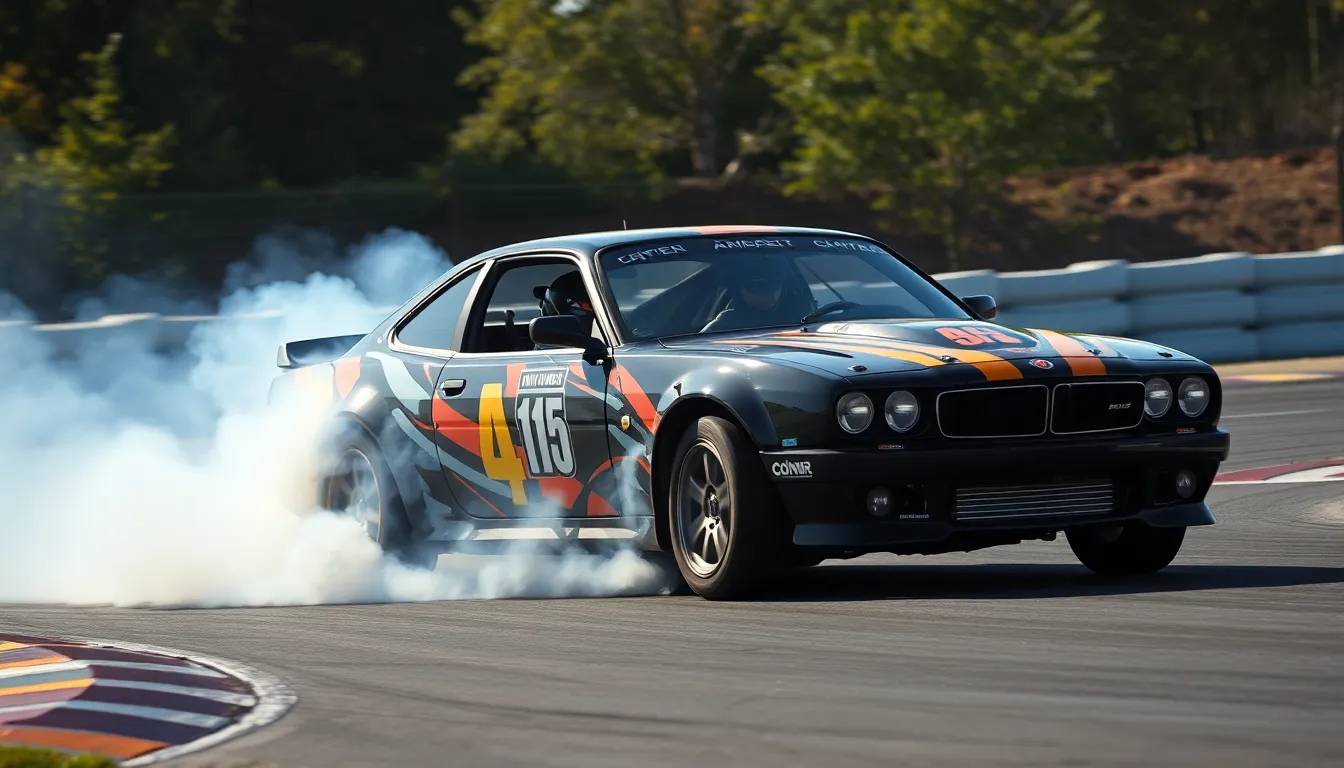
Mastering drifting requires understanding exact techniques that allow drivers to initiate and control sideways motion. We’ll explore the fundamental methods every drift enthusiast needs to develop.
Initiating Drift with Clutch Kicks and Handbrakes
Clutch kick techniques break rear wheel traction by creating sudden power surges to the drivetrain. We recommend quickly depressing and releasing the clutch pedal while maintaining throttle input, causing the rear wheels to spin and lose grip. This method works best at speeds between 30-50 mph and requires precise timing to avoid stalling the engine.
Handbrake initiation provides the most accessible entry point for beginners learning drift fundamentals. We pull the handbrake lever sharply while turning into the corner, locking the rear wheels temporarily and forcing the car’s rear end to step out. Modern drift cars often feature hydraulic handbrakes that offer better modulation than traditional cable systems.
Power over techniques use engine torque to overcome rear tire grip through aggressive throttle application. We accelerate hard while entering corners, allowing the engine’s power to break traction naturally. This method requires rear-wheel drive vehicles with sufficient horsepower, typically 200+ hp for effective results.
Feint drift initiation involves quick steering inputs in the opposite direction before entering the actual turn. We steer left briefly before turning right, transferring weight and unsettling the car’s balance to promote oversteer. Professional drivers frequently combine this technique with throttle modulation for smoother entries.
Maintaining Control Through Throttle Management
Throttle modulation becomes the primary tool for controlling drift angle and speed once sideways motion begins. We adjust accelerator pressure constantly, adding throttle to increase drift angle or reducing power to tighten the line. Smooth, progressive inputs prevent sudden traction recovery that could destabilize the vehicle.
Power delivery timing determines whether the drift continues smoothly or ends abruptly with a snap back. We apply throttle just before the car begins to straighten, maintaining rear wheel slip throughout the corner. Gas pedal sensitivity varies between vehicles, with turbocharged engines requiring more careful modulation due to boost lag.
Engine braking techniques help control speed without completely breaking the drift state. We lift off the throttle gradually while maintaining steering angle, allowing engine compression to slow the vehicle. This method proves especially useful in tight corners where excessive speed threatens track boundaries.
Throttle steering allows experienced drivers to adjust their line using only accelerator inputs. We increase throttle to push the car wider or reduce power to tighten the radius, effectively steering with the right foot. Mastering this technique takes hundreds of practice hours and intimate knowledge of your exact vehicle’s characteristics.
Counter-Steering and Weight Transfer Methods
Counter-steering application requires turning the steering wheel opposite to the direction of the drift to maintain control. We turn right when the car’s rear slides left, keeping the vehicle pointed toward our intended path. The amount of counter-steer needed varies with drift angle, speed, and surface conditions.
Steering wheel speed directly affects the car’s stability during drift transitions. We make quick initial corrections followed by slower, more deliberate adjustments as the drift stabilizes. Jerky or oversized steering inputs often result in tank slappers or complete loss of control.
Weight transfer manipulation uses the car’s momentum to enhance or reduce drift characteristics. We shift weight forward through braking or backward through acceleration, affecting which end of the car wants to slide. Understanding your vehicle’s weight distribution helps predict how it’ll respond to different transfer techniques.
Transition techniques between left and right drifts require precise coordination of steering, throttle, and weight transfer. We flick the steering wheel from full lock in one direction to full lock in the other while modulating throttle to maintain rear wheel slip. Professional drivers execute these transitions in fractions of a second, creating the flowing S-curves characteristic of competitive drifting.
Safety Equipment Required for Drifting Cars
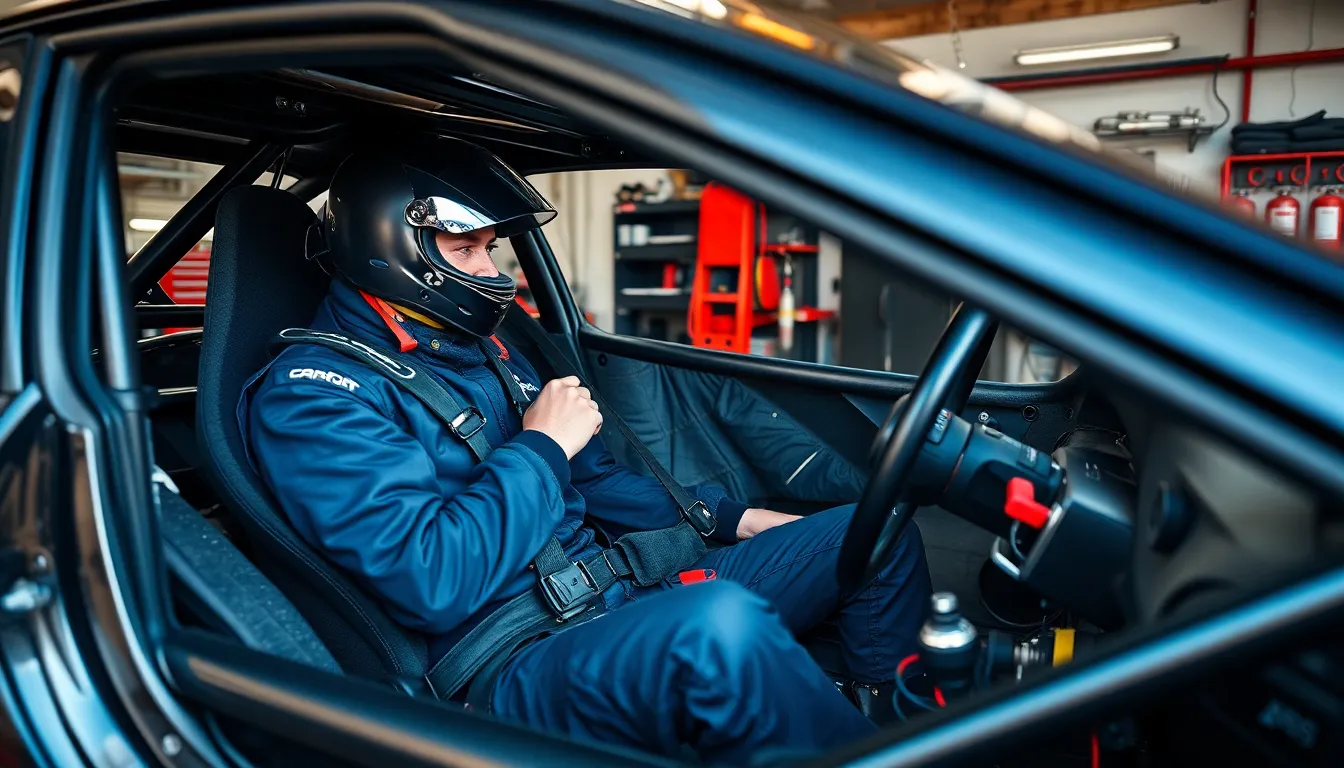
Professional drifting demands comprehensive safety equipment that protects drivers during high-speed sideways maneuvers. We’ll explore the essential safety components that transform standard vehicles into track-ready drift machines.
Roll Cages and Structural Reinforcements
Roll cages provide the primary structural protection for drifting cars during potential rollovers or impacts. We install multi-point roll cages that connect to the vehicle’s chassis at 6, 8, or 10 mounting points, creating a protective cocoon around the driver compartment. Professional drift competitions typically require FIA-approved or SCCA-certified roll cage specifications that meet strict dimensional and material requirements.
Structural reinforcements complement roll cage installations by strengthening vulnerable chassis areas. We add door bars, roof reinforcement plates, and floor pan stiffening plates to distribute impact forces throughout the vehicle structure. These modifications prevent chassis flex during aggressive cornering and provide additional protection zones around the driver.
Proper installation requires professional welding techniques and precise measurements to maintain structural integrity. We ensure all roll cage tubes meet minimum wall thickness requirements of 0.120 inches for steel construction or 0.125 inches for chromoly tubing. The cage design must allow adequate clearance between the driver’s helmet and bars during normal seating positions.
Racing Seats and Harness Systems
Racing seats anchor drivers securely during extreme lateral forces encountered in competitive drifting. We select FIA-homologated seats with deep side bolsters, integrated head restraints, and mounting points designed for multi-point harness systems. These seats position drivers lower in the vehicle while providing superior support compared to factory seating.
Harness systems distribute crash forces across the driver’s torso through multiple attachment points. We install 5-point or 6-point racing harnesses that include shoulder straps, lap belts, and anti-submarine straps to prevent occupant ejection. The harness mounting points must attach directly to the roll cage or reinforced chassis components rather than factory seat belt mounting locations.
Regular inspection schedules ensure harness webbing remains free from cuts, fraying, or UV damage that could compromise safety performance. We replace racing harnesses every 5 years or immediately after any important impact, following manufacturer recommendations for competitive motorsports applications.
Fire Suppression and Safety Gear
Fire suppression systems protect against fuel-related fires common in high-performance drift vehicles. We install automatic or manual fire suppression systems using clean agents like AFFF foam or Novec 1230 that won’t damage sensitive electronic components. These systems include distribution nozzles positioned throughout the engine bay, cockpit, and fuel cell areas.
Driver safety gear includes fire-resistant racing suits rated for motorsports competition. We recommend SFI 3.2A/5 or FIA 8856-2018 certified suits that provide protection against flash fires for 10-15 seconds. Racing gloves, shoes, and underwear complete the fire protection ensemble required for professional drifting events.
Emergency equipment includes quick-release mechanisms for steering wheels, window nets, and accessible fire extinguisher mounting. We position manual fire suppression controls within easy reach of the driver’s seat and mark activation switches with bright colors for emergency identification. These systems provide crucial seconds for driver evacuation during fire emergencies.
Finding Legal Places to Practice Drifting

After mastering safety equipment and drift car modifications, we need secure locations to practice our techniques legally and safely.
Professional Drift Tracks and Events
Professional drift circuits offer the safest environment for developing our sideways driving skills. Formula Drift championship tracks like Irwindale Speedway in California and Atlanta Motor Speedway in Georgia provide dedicated drift facilities with proper barriers and safety infrastructure. Circuit of the Americas in Austin hosts multiple drift events throughout the year, featuring both amateur and professional competitions.
Established tracks maintain specialized drift configurations with wide entry points and runoff areas designed for controlled oversteer practice. Willow Springs Raceway offers dedicated drift weekends where we can practice alongside experienced drivers who share setup advice and driving techniques. Road Atlanta’s drift track features varying elevation changes that help us master weight transfer dynamics across different terrain conditions.
Track memberships typically cost between $200-500 annually and provide access to member only practice sessions throughout the racing season. Many facilities offer coaching programs where professional drivers provide personalized instruction on throttle management and counter steering techniques. We’ll find these structured environments invaluable for progressing from basic drift initiation to advanced tandem driving skills.
Sanctioned Drift Days and Track Rentals
Sanctioned drift organizations host regular practice events at racetracks nationwide, providing affordable alternatives to professional circuit training. Drift Alliance and Kings of Drift coordinate monthly events at tracks like Sonoma Raceway and New Jersey Motorsports Park. These events cost between $150-300 per driver and include tech inspections, safety briefings, and multiple practice sessions.
Track rental groups organize shared costs among multiple drivers, reducing individual expenses while maximizing seat time. We can join Facebook groups and online forums where local drift communities coordinate group bookings at facilities like Thunderhill Raceway or VIRginia International Raceway. Most rental sessions last 6-8 hours and accommodate 20-30 vehicles depending on track configuration.
Drift schools operate at various tracks offering structured learning environments with professional instruction. Formula Drift Academy provides weekend courses covering everything from basic car control to advanced competition techniques. Students receive hands on guidance for perfecting clutch kicks, handbrake entries, and smooth transitions between linked corners.
Avoiding Street Drifting and Legal Consequences
Street drifting carries severe legal penalties including vehicle impoundment, license suspension, and criminal charges in most jurisdictions. Reckless driving citations can result in fines exceeding $2,000 plus court costs and mandatory driving courses. California Vehicle Code 23103 specifically targets exhibition of speed violations, which include drifting maneuvers on public roads.
Insurance implications extend beyond immediate legal troubles, as street racing convictions often trigger policy cancellations and dramatically increased premiums. We risk losing coverage entirely when insurance companies discover illegal driving activities through police reports or social media evidence. Many insurers now monitor social platforms and will void policies based on posted content showing dangerous driving behavior.
Criminal penalties escalate quickly when street drifting results in property damage or injuries to bystanders. Vehicular manslaughter charges apply when illegal driving activities cause fatalities, carrying potential prison sentences exceeding 10 years. We strongly recommend channeling our drifting passion toward legal venues where we can practice safely without endangering innocent people or facing life changing legal consequences.
The Competitive Drifting Scene
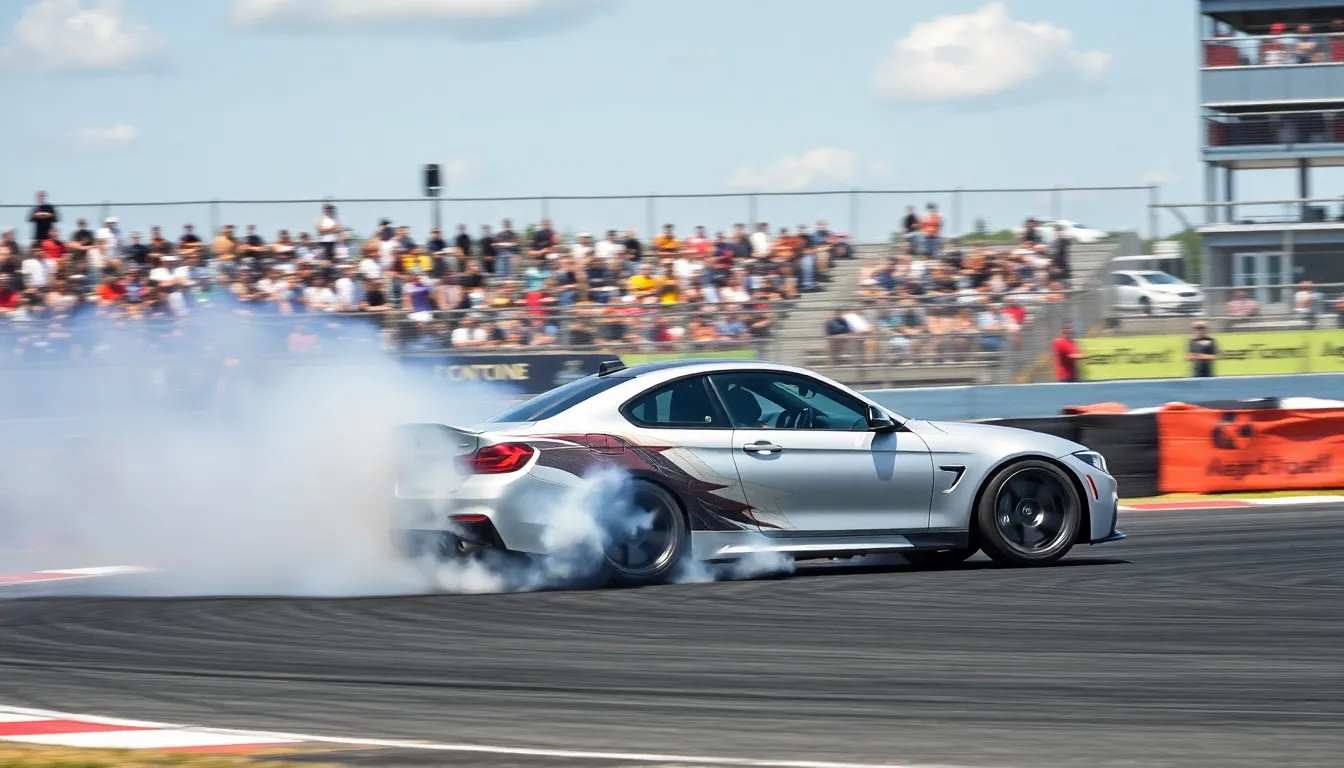
Professional drifting has transformed from underground street racing into a globally recognized motorsport with established series and championships. We’ll explore the organized competitive industry that attracts thousands of spectators and offers lucrative opportunities for skilled drivers.
Professional Drift Series and Championships
Formula Drift stands as North America’s premier professional drifting championship, featuring events across iconic venues like Long Beach and Atlanta Motor Speedway. Established drivers compete for substantial prize pools exceeding $100,000 annually, while manufacturers invest heavily in team sponsorships and vehicle development programs.
D1 Grand Prix represents Japan’s original professional drift series, maintaining the sport’s authentic roots since 2001. Top-tier Japanese drivers showcase cutting-edge techniques on legendary circuits like Ebisu and Suzuka, influencing global drifting standards through televised competitions.
Drift Masters European Championship has emerged as Europe’s fastest-growing drift series, attracting international talent to venues across Poland, Latvia, and Germany. Professional drivers travel thousands of miles to compete in this prestigious series, which offers direct qualification paths to global championships.
King of Europe provides another major competitive platform, featuring multiple rounds across European circuits with points-based championship standings. Drivers accumulate points through consistent performance across various track layouts, creating intense season-long battles for championship titles.
Judging Criteria in Drift Competitions
Line scoring evaluates how precisely drivers follow predetermined racing lines through each corner section. Judges award maximum points when vehicles maintain optimal proximity to clipping points while executing smooth, flowing transitions between drift zones.
Angle measurements assess the degree of sideways motion throughout each run, with professional competitions requiring sustained angles between 30-45 degrees. Consistent angle maintenance demonstrates superior car control and separates amateur performers from championship-level competitors.
Speed evaluation considers entry velocity and momentum preservation throughout drift sequences, rewarding drivers who maintain higher speeds while executing technical maneuvers. Professional judges use timing systems and visual assessment to score speed components accurately.
Style points recognize unique driving techniques, vehicle presentation, and crowd engagement factors that enhance overall performance quality. Judges award bonus points for creative line choices, aggressive driving styles, and exceptional showmanship during competitive runs.
Proximity scoring in tandem battles measures following drivers’ ability to maintain close distances while matching lead cars’ movements. Professional competitions require following distances of 3-5 feet, creating intense pressure situations that test advanced driving skills.
Building Skills for Competition Level
Track time accumulation forms the foundation of competitive drift development, with professional drivers logging 100+ practice hours annually at various circuit configurations. Consistent practice across different track layouts builds muscle memory and develops the reflexes necessary for high-level competition.
Professional instruction accelerates skill development through structured learning programs offered by drift schools and experienced competitors. Advanced students work directly with championship drivers to refine techniques and learn competition-exact strategies.
Video analysis helps drivers identify improvement areas by reviewing footage of successful runs alongside championship-level performances. Modern drift teams use telemetry data and slow-motion analysis to optimize driving lines and throttle management techniques.
Physical conditioning programs enhance drivers’ endurance and reaction times during extended competition sessions lasting 8-12 hours. Professional drifters maintain cardiovascular fitness and core strength to handle extreme G-forces throughout multiple qualifying and finals runs.
Mental preparation training develops focus and pressure management skills essential for championship-level performance under intense competition conditions. Sports psychologists work with professional drift teams to build confidence and maintain consistency during high-stakes battles.
Maintenance Challenges of Drifting Cars
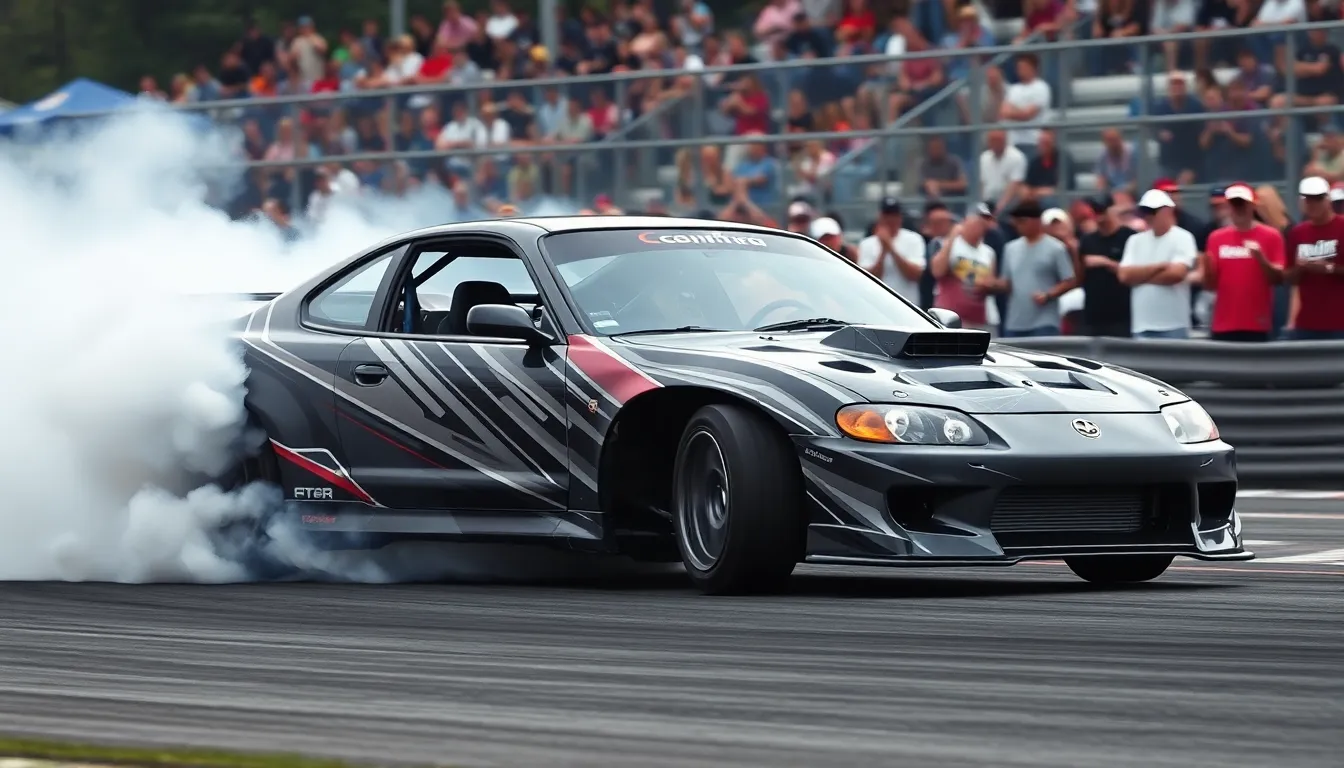
Maintaining drift cars requires significantly more attention and resources than regular street vehicles. We’ll explore the unique challenges that come with keeping these high-performance machines in peak condition.
Tire Wear and Replacement Costs
Tire expenses represent the largest ongoing cost for any serious drift enthusiast. We burn through rear tires at an alarming rate during practice sessions and competitions. Professional drifters typically consume between 4-6 sets of rear tires per event day, with each set costing $300-800 depending on tire compound and brand.
Competition events accelerate tire wear dramatically compared to street driving. Drifting generates extreme lateral forces that shred tire compounds within minutes rather than thousands of miles. Quality drift tires like Falken Azenis RT615K+ or Nitto NT05 offer better grip and longevity but command premium prices.
Budget tire rotation becomes impossible with drift setups since front tires experience minimal wear while rears get destroyed. Many drift teams purchase tires in bulk quantities to reduce per-unit costs. Warehouse purchases of 20-30 tires at once can save hundreds of dollars through volume discounts.
Tire pressure monitoring becomes critical for maximizing tire life and performance. Lower pressures around 25-30 PSI help distribute heat more evenly across the contact patch. Higher pressures above 35 PSI cause center tread wear and reduced grip during sustained slides.
Mechanical Stress on Drivetrain Components
Drivetrain components endure punishment that exceeds normal vehicle operation by 500-800%. We subject clutches, differentials, and driveshafts to constant high-stress situations that accelerate wear patterns. Clutch replacements occur every 10,000-15,000 miles in dedicated drift cars compared to 60,000+ miles in street vehicles.
Limited slip differentials require rebuild services every 20-30 track days depending on driving intensity. Clutch pack differentials need friction disc replacements costing $400-600 per service. Gear oil changes become essential after every 3-4 events to prevent overheating damage.
Driveshaft universal joints fail regularly under the constant direction changes and power delivery spikes. Quality aftermarket driveshafts with stronger U-joints cost $600-1,200 but last significantly longer than stock components. CV joints on front-wheel-drive converted drift cars experience similar stress levels.
Engine mounts and transmission mounts loosen frequently from violent weight transfers and power applications. Polyurethane bushings provide better durability than rubber but transfer more vibration to the chassis. Metal mounts offer maximum strength but create harsh driving conditions for street use.
Budget Planning for Drift Car Upkeep
Annual maintenance budgets for active drift cars range from $8,000-15,000 depending on competition frequency. We recommend setting aside $200-400 per track day for consumables and potential repairs. These figures include tires, fluids, brake pads, and minor component replacements.
Major component failures require emergency fund reserves of $3,000-5,000 for engine or transmission rebuilds. Differential rebuilds cost $800-1,500 while clutch replacements range from $600-1,200 including labor. Suspension component replacements add another $500-1,000 annually.
Parts inventory management reduces downtime between events and practice sessions. Stocking common wear items like brake pads, spark plugs, air filters, and fluids prevents last-minute scrambling. Bulk purchasing of consumables provides cost savings and ensures availability.
Professional maintenance relationships with specialized drift shops streamline repair processes and reduce labor costs. Experienced drift mechanics understand common failure points and provide preventive maintenance recommendations. Building these relationships early saves money and prevents catastrophic failures during competition season.
Track day insurance policies protect against catastrophic damage that could exceed vehicle value. Policies cost $200-500 per event but cover collision damage and mechanical failures. Some sanctioning bodies require minimum coverage levels for competition participation.
Conclusion
Drifting represents far more than just sideways driving – it’s a complete lifestyle that demands dedication skill and important investment. We’ve explored how this Japanese-born art form has transformed into a global phenomenon that continues to attract passionate enthusiasts worldwide.
Whether you’re drawn to the technical aspects of car modifications the precision required for competitive events or simply the pure adrenaline rush of controlled chaos drifting offers something unique in motorsports. The journey from understanding basic physics to mastering advanced techniques requires patience practice and respect for safety protocols.
Remember that successful drifting isn’t just about having the right car or modifications – it’s about developing the skills maintaining your vehicle properly and always prioritizing safety over spectacle. The drifting community welcomes newcomers who approach the sport with genuine respect and commitment to continuous learning.
Frequently Asked Questions
What is drifting and how did it originate?
Drifting is a driving technique where drivers intentionally oversteer their cars to maintain controlled sideways motion through corners. It originated from Japan’s mountain roads and has evolved into a popular global motorsport phenomenon, captivating millions of fans with skilled drivers maneuvering their vehicles with precision.
What makes a good drift car?
A good drift car requires rear-wheel drive systems, optimal weight distribution, and proper power delivery characteristics. Essential modifications include suspension upgrades like coilover systems, limited slip differentials for consistent power delivery, and manual transmissions. These features work together to enable controlled oversteer and sideways motion.
Which cars are best for beginners in drifting?
Popular beginner drift cars include the Nissan 240SX (S-chassis) for its perfect weight distribution, BMW E30 and E36 series for their balanced handling and build quality, and the Toyota AE86 for its forgiving characteristics and cultural significance in drifting history.
What are the basic drifting techniques?
Essential drifting techniques include drift initiation methods like clutch kicks, handbrake pulls, and power-over techniques. Mastering throttle management, counter-steering, weight transfer, and smooth transitions between drifts are crucial skills for controlling the vehicle during sideways motion and maintaining proper drift angles.
What safety equipment is required for drifting?
Professional drifting requires multi-point roll cages, racing seats with harness systems, fire suppression systems, and driver safety gear including fire-resistant suits and gloves. Regular safety equipment inspections and quick-release mechanisms are essential for protecting drivers during high-performance drifting activities.
Where can I legally practice drifting?
Legal drifting venues include professional drift tracks like Irwindale Speedway and Atlanta Motor Speedway, sanctioned drift days, track rentals, and drift schools with professional instruction. Street drifting is illegal and can result in hefty fines, vehicle impoundment, and criminal charges.
How are drift competitions judged?
Drift competitions are judged on multiple criteria including line scoring (following the ideal racing line), angle measurements, speed evaluation, style points for smoothness and flair, and proximity scoring during tandem battles. These elements combine to determine overall performance rankings.
How much does it cost to maintain a drift car?
Drift car maintenance is expensive due to rapid tire wear (multiple sets per event), frequent drivetrain component replacements (clutches, differentials, driveshafts), and potential major repairs. Budget planning should include funds for consumables, parts inventory, and track day insurance for catastrophic damage protection.

